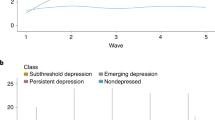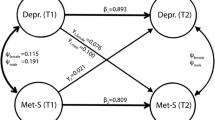Abstract
Background
We sought to identify depressive symptom subgroups in a community sample of young adults, investigate their stability over time, and determine their association with prevalent and incident cardiovascular disease (CVD) risk factors.
Method
Participants were 3377 adults from the Coronary Artery Risk Development in Young Adults study. Using latent class and latent transition analysis, we derived subgroups based on items of the 20-item version of the Center for Epidemiologic Studies Depression Scale in 1990, and examined patterns of change over a 10-year period (1990–2000). Cox regression models were used to examine associations between subgroup membership and prevalent (2000) and incident (2000 to 2016) obesity, hypertension, and diabetes.
Results
Three baseline subgroups were identified and labeled: “No Symptoms” (63.5%), “Lack of Positive Affect” (PA, 25.6%), and “Depressed Mood” (10.9%). At 10-year follow-up, individuals in “No Symptoms” subgroup had the highest probability (0.84) of being classified within the same subgroup. Participants classified as “Lack of PA” were likely (0.46) to remain in the same subgroup or be classified as “No Symptoms.” Participants in the “Depressed Mood” were most likely to transition to the “Lack of PA” subgroup (0.38). Overall, 30.5% of participants transitioned between subgroups, with 11.4% classified as “Worsening” and 19.1% as “Improving.” Relative to the “No Symptoms Stable,” other subgroups (“Depressed Stable,” “Worsening,” and “Improving”) were associated with prevalent obesity and hypertension.
Conclusion
We identified distinct depressive symptom subgroups that are variably stable over time, and their change patterns were differentially associated with CVD risk factor prevalence.


Similar content being viewed by others
References
Van der Kooy K, van Hout H, Marwijk H, Marten H, Stehouwer C, Beekman A. Depression and the risk for cardiovascular diseases: systematic review and meta analysis. Int J Geriatr Psychiatry. 2007;22(7):613–26. https://doi.org/10.1002/gps.1723.
Carney RM, Freedland KE. Depression and coronary heart disease. Nat Rev Cardiol. 2017;14(3):145–55. https://doi.org/10.1038/nrcardio.2016.181.
Everson SA, Maty SC, Lynch JW, Kaplan GA. Epidemiologic evidence for the relation between socioeconomic status and depression, obesity, and diabetes. J Psychosom Res. 2002;53(4):891–5.
Vaccarino V, McClure C, Johnson BD, et al. Depression, the metabolic syndrome and cardiovascular risk. Psychosom Med. 2008;70(1):40–8. https://doi.org/10.1097/PSY.0b013e31815c1b85.
Steptoe A, Kunz-Ebrecht SR, Owen N. Lack of association between depressive symptoms and markers of immune and vascular inflammation in middle-aged men and women. Psychol Med. 2003;33(4):667–74. https://doi.org/10.1017/S0033291702007250.
Carney RM, Freedland KE. Is there a high-risk subtype of depression in patients with coronary heart disease? Curr Psychiatry Rep. 2012;14(1):1–7. https://doi.org/10.1007/s11920-011-0247-6.
Dozois DJ, Dobson KS, Ahnberg JL. A psychometric evaluation of the Beck Depression Inventory–II. Psychol Assess. 1998;10(2):83.
Mezuk B, Kendler KS. Examining variation in depressive symptoms over the life course: a latent class analysis. Psychol Med. 2012;42(10):2037–46. https://doi.org/10.1017/S003329171200027X.
Gallo JJ, Rabins PV, Lyketsos CG, Tien AY, Anthony JC. Depression without sadness: functional outcomes of nondysphoric depression in later life. J Am Geriatr Soc. 1997;45(5):570–8. https://doi.org/10.1111/j.1532-5415.1997.tb03089.x.
Gallo JJ, Rabins PV, Anthony JC. Sadness in older persons: 13-year follow-up of a community sample in Baltimore. Maryland Psychol Med. 1999;29(2):341–50.
Gallo JJ, Rabins PV. Depression without sadness: alternative presentations of depression in late life. Am Fam Physician. 1999;60(3):820–6.
Luppino FS, van Reedt Dortland AK, Wardenaar KJ, et al. Symptom dimensions of depression and anxiety and the metabolic syndrome. Psychosom Med. 2011;73(3):257–64. https://doi.org/10.1097/PSY.0b013e31820a59c0.
Steptoe A, Wardle J, Marmot M. Positive affect and health-related neuroendocrine, cardiovascular, and inflammatory processes. Proc Natl Acad Sci USA. 2005;102(18):6508–12.
Freak-Poli R, Mirza SS, Franco OH, Ikram MA, Hofman A, Tiemeier H. Positive affect is not associated with incidence of cardiovascular disease: a population-based study of older persons. Prev Med. 2015;74:14–20. https://doi.org/10.1016/j.ypmed.2015.01.032.
Boehm JK, Chen Y, Qureshi F, et al. Positive emotions and favorable cardiovascular health: a 20-year longitudinal study. Prev Med. 2020;136:106103. https://doi.org/10.1016/j.ypmed.2020.106103.
Carney RM, Freedland KE. Are somatic symptoms of depression better predictors of cardiac events than cognitive symptoms in coronary heart disease? Psychosom Med. 2012;74(1):33–8. https://doi.org/10.1097/PSY.0b013e3182405ac4.
Association AP. Diagnostic and statistical manual of mental disorders (DSM-5®). American Psychiatric Pub; 2013.
Collins LM, Lanza ST. Latent class and latent transition analysis: with applications in the social, behavioral, and health sciences. John Wiley & Sons; 2013.
Friedman GD, Cutter GR, Donahue RP, et al. CARDIA: study design, recruitment, and some characteristics of the examined subjects. J Clin Epidemiol. 1988;41(11):1105–16.
Hughes GH, Cutter G, Donahue R, et al. Recruitment in the coronary artery disease risk development in young adults (Cardia) study. Control Clin Trials. 1987;8(4 Suppl):68S–73S.
Radloff LS. The CES-D scale a self-report depression scale for research in the general population. Appl Psychol Meas. 1977;1(3):385–401.
Jacobs DR Jr, Hahn LP, Haskell WL, Pirie P, Sidney S. Validity and reliability of short physical activity history: Cardia and the Minnesota Heart Health Program. J Cardiopulm Rehabil. 1989;9(11):448–59.
Ni Y, Tein JY, Zhang M, Yang Y, Wu G. Changes in depression among older adults in China: a latent transition analysis. J Affect Disord. 2017;209:3–9. https://doi.org/10.1016/j.jad.2016.11.004.
Chirinos DA, Murdock KW, LeRoy AS, Fagundes C. Depressive symptom profiles, cardio-metabolic risk and inflammation: Results from the MIDUS study. Psychoneuroendocrinology. 2017;82:17–25. https://doi.org/10.1016/j.psyneuen.2017.04.011.
Chen L, Eaton WW, Gallo JJ, Nestadt G. Understanding the heterogeneity of depression through the triad of symptoms, course and risk factors: a longitudinal, population-based study. J Affect Disord. 2000;59(1):1–11.
Overall JE, Hollister LE, Johnson M, Pennington V. NOsology of depression and differential response to drugs. JAMA. 1966;195(11):946–8. https://doi.org/10.1001/jama.1966.03100110114031.
Ulbricht CM, Dumenci L, Rothschild AJ, Lapane KL. Changes in depression subtypes among men in STAR*D: a latent transition analysis. Am J Mens Health. 2018;12(1):5–13. https://doi.org/10.1177/1557988315607297.
Ulbricht CM, Dumenci L, Rothschild AJ, Lapane KL. Changes in depression subtypes for women during treatment with citalopram: a latent transition analysis. Arch Womens Ment Health. 2016;19(5):769–78. https://doi.org/10.1007/s00737-016-0606-8.
Kendler KS, Eaves LJ, Walters EE, Neale MC, Heath AC, Kessler RC. The identification and validation of distinct depressive syndromes in a population-based sample of female twins. Arch Gen Psychiatry. 1996;53(5):391–9. https://doi.org/10.1001/archpsyc.1996.01830050025004.
Landau S, Harris V, Burn DJ, et al. Anxiety and anxious-depression in Parkinson’s disease over a 4-year period: a latent transition analysis. Psychol Med. 2016;46(3):657–67. https://doi.org/10.1017/S0033291715002196.
Hasin DS, Sarvet AL, Meyers JL, et al. Epidemiology of adult DSM-5 major depressive disorder and its specifiers in the United States. JAMA Psychiat. 2018;75(4):336–46. https://doi.org/10.1001/jamapsychiatry.2017.4602.
Rodgers S, Ajdacic-Gross V, Muller M, et al. The role of sex on stability and change of depression symptom subtypes over 20 years: a latent transition analysis. Eur Arch Psychiatry Clin Neurosci. 2014;264(7):577–88. https://doi.org/10.1007/s00406-013-0475-3.
Lohman MC, Mezuk B, Dumenci L. Depression and frailty: concurrent risks for adverse health outcomes. Aging Ment Health. 2017;21(4):399–408. https://doi.org/10.1080/13607863.2015.1102199.
Ma J, Rosas LG, Lv N, et al. Effect of integrated behavioral weight loss treatment and problem-solving therapy on body mass index and depressive symptoms among patients with obesity and depression: the RAINBOW randomized clinical trial. JAMA. 2019;321(9):869–79. https://doi.org/10.1001/jama.2019.0557.
Linde JA, Simon GE, Ludman EJ, et al. A randomized controlled trial of behavioral weight loss treatment versus combined weight loss/depression treatment among women with comorbid obesity and depression. Ann Behav Med. 2010;41(1):119–30. https://doi.org/10.1007/s12160-010-9232-2.
Pagoto S, Schneider KL, Whited MC, et al. Randomized controlled trial of behavioral treatment for comorbid obesity and depression in women: the Be Active Trial. Int J Obes. 2013;37(11):1427–34. https://doi.org/10.1038/ijo.2013.25.
Zhang A, Park S, Sullivan JE, Jing S. The effectiveness of problem-solving therapy for primary care patients’ depressive and/or anxiety disorders: a systematic review and meta-analysis. J Am Board Fam Med. 2018;31(1):139–50. https://doi.org/10.3122/jabfm.2018.01.170270.
Ciechanowski P, Wagner E, Schmaling K, et al. Community-integrated home-based depression treatment in older adultsa randomized controlled trial. JAMA. 2004;291(13):1569–77. https://doi.org/10.1001/jama.291.13.1569.
Marijnissen RM, Bus BA, Holewijn S, et al. Depressive symptom clusters are differentially associated with general and visceral obesity. J Am Geriatr Soc. 2011;59(1):67–72.
Luppino FS, de Wit LM, Bouvy PF, et al. Overweight, obesity, and depression: a systematic review and meta-analysis of longitudinal studies. JAMA Psychiat. 2010;67(3):220–9. https://doi.org/10.1001/archgenpsychiatry.2010.2.
Bjorntorp P, Rosmond R. Hypothalamic origin of the metabolic syndrome X. Ann N Y Acad Sci. 1999;892:297–307. https://doi.org/10.1111/j.1749-6632.1999.tb07803.x.
Burkhauser RV, Cawley J. Beyond BMI: the value of more accurate measures of fatness and obesity in social science research. J Health Econ. 2008;27(2):519–29. https://doi.org/10.1016/j.jhealeco.2007.05.005.
Raikkonen K, Matthews KA, Kuller LH. Trajectory of psychological risk and incident hypertension in middle-aged women. Hypertension. 2001;38(4):798–802.
Wiehe M, Fuchs SC, Moreira LB, et al. Absence of association between depression and hypertension: results of a prospectively designed population-based study. J Hum Hypertens. 2006;20(6):434–9. https://doi.org/10.1038/sj.jhh.1002017.
Pan Y, Cai W, Cheng Q, Dong W, An T, Yan J. Association between anxiety and hypertension: a systematic review and meta-analysis of epidemiological studies. Neuropsychiatr Dis Treat. 2015;11:1121–30. https://doi.org/10.2147/NDT.S77710.
Davidson K, Jonas BS, Dixon KE, Markovitz JH. Do depression symptoms predict early hypertension incidence in young adults in the CARDIA study? Coronary Artery Risk Development in Young Adults. Arch Intern Med. 2000;160(10):1495–500.
Mezuk B, Johnson-Lawrence V, Lee H, et al. Is ignorance bliss? Depression, antidepressants, and the diagnosis of prediabetes and type 2 diabetes. Health Psychol. 2013;32(3):254–63. https://doi.org/10.1037/a0029014.
Nouwen A, Nefs G, Caramlau I, et al. Prevalence of depression in individuals with impaired glucose metabolism or undiagnosed diabetes: a systematic review and meta-analysis of the European Depression in Diabetes (EDID) Research Consortium. Diabetes Care. 2011;34(3):752–62. https://doi.org/10.2337/dc10-1414.
Raikkonen K, Matthews KA, Kuller LH. Depressive symptoms and stressful life events predict metabolic syndrome among middle-aged women: a comparison of World Health Organization, Adult Treatment Panel III, and International Diabetes Foundation definitions. Diabetes Care. 2007;30(4):872–7. https://doi.org/10.2337/dc06-1857.
Lorenz MW, Markus HS, Bots ML, Rosvall M, Sitzer M. Prediction of clinical cardiovascular events with carotid intima-media thickness: a systematic review and meta-analysis. Circulation. 2007;115(4):459–67. https://doi.org/10.1161/CIRCULATIONAHA.106.628875.
Brummett BH, Babyak MA, Siegler IC, Mark DB, Williams RB, Barefoot JC. Effect of smoking and sedentary behavior on the association between depressive symptoms and mortality from coronary heart disease. Am J Cardiol. 2003;92(5):529–32. https://doi.org/10.1016/S0002-9149(03)00719-7.
Strike PC, A Steptoe. Psychosocial factors in the development of coronary artery disease. Prog Cardiovasc Dis. 2004;46(4):337–47. https://doi.org/10.1016/j.pcad.2003.09.001.
Carney RM, Freedland KE, Stein PK. Anxiety, depression, and heart rate variability Psychosom Med. 2000;62(1):84–7.
Yasunari K, Matsui T, Maeda K, Nakamura M, Watanabe T, Kiriike N. Anxiety-induced plasma norepinephrine augmentation increases reactive oxygen species formation by monocytes in essential hypertension. Am J Hypertens. 2006;19(6):573–8. https://doi.org/10.1016/j.amjhyper.2005.10.027.
Chirinos DA, Goldberg R, Gellman M et al. Leptin and its association with somatic depressive symptoms in patients with the metabolic syndrome. Ann Behav Med. 2013;46(1):31–9. https://doi.org/10.1007/s12160-013-9479-5 .
Garbarski D. Racial/ethnic disparities in midlife depressive symptoms: the role of cumulative disadvantage across the life course. Adv Life Course Res. 2015;23:67–85. https://doi.org/10.1016/j.alcr.2014.12.006.
Funding
The Coronary Artery Risk Development in Young Adults Study (CARDIA) is supported by contracts HHSN268201800003I, HHSN268201800004I, HHSN268201800005I, HHSN268201800006I, and HHSN268201800007I from the National Heart, Lung, and Blood Institute (NHLBI). DC is supported by 1K01HL149987-01A1 from the NHLBI.
Author information
Authors and Affiliations
Corresponding author
Ethics declarations
Statement on Informed Consent and Ethics Approval
Written informed consent was obtained at each examination. All procedures were approved by the Institutional Review Board at each field center and with the 1964 Helsinki declaration and its later amendments or comparable ethical standards.
Conflict of Interest
The authors declare no competing interests.
Additional information
Publisher's Note
Springer Nature remains neutral with regard to jurisdictional claims in published maps and institutional affiliations.
Supplementary Information
Below is the link to the electronic supplementary material.
Rights and permissions
Springer Nature or its licensor (e.g. a society or other partner) holds exclusive rights to this article under a publishing agreement with the author(s) or other rightsholder(s); author self-archiving of the accepted manuscript version of this article is solely governed by the terms of such publishing agreement and applicable law.
About this article
Cite this article
Chirinos, D.A., Kershaw, K.N., Allen, N.B. et al. Depressive Symptom Subgroups and Their Association with Prevalent and Incident Cardiovascular Risk Factors in the Coronary Artery Risk Development in Young Adults (CARDIA) Study. Int.J. Behav. Med. 30, 891–903 (2023). https://doi.org/10.1007/s12529-022-10144-z
Accepted:
Published:
Issue Date:
DOI: https://doi.org/10.1007/s12529-022-10144-z




